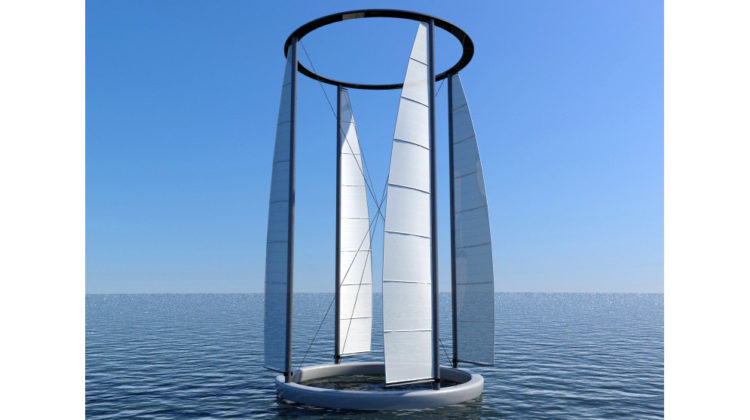
American Offshore Energy (AOE) has announced novel patents for a radical new design for a floating wind turbine inspired by America’s Cup yachts.
AOE’s vertical-axis turbine is the first wind turbine without a centre shaft. Instead, the bearings and electrical generation are at the perimeter, where there are high surface speeds even at low RPMs, eliminating the need for rolling bearings, gearboxes and oil. According to the company, its design team used clever design principles to avoid moment forces being transmitted to the floating base, which means that the floats may be made from fibreglass, drastically reducing the use of steel and thus the turbine’s weight. Being sailboat racers themselves, the team took inspiration from the America’s Cup race yachts, building a lightweight but powerful aerodynamic rotor that can be ‘trimmed’ to suit the conditions.
The principle behind the turbine is to reach up into the wind with a lightweight structure, keeping the heavier bearings and generator near sea level. This design helps to make it more sustainable.
The fluid film bearing technology separates axial and radial loads, so the axial bearings, which carry the weight of the rotating assembly, may push down or pull up on a float, but can’t introduce a moment load. Because the floats are loaded in only tension or compression, they can be made from fibreglass at a tenth of the weight per unit of energy produced of the oil-derrick-like floats required for the standard horizontal-axis designs. These designs have the loads and masses at the top of a long pole and are cantilevered, so a 50-tonne force at the top of a 100-metre tower puts more than 500 tonnes of force into a floating base that is holding the bottom ten metres, which is why they require so much steel.
The turbine’s design removed the need for forgings, castings, rolling element bearings, gearboxes, conventional generators or AC/DC conversions at sea. The reduced weight means that they can be launched from a much greater number of sites and towed and serviced by existing vessels.
‘All the other VAWT offerings employ a centre shaft,’ said Drew Devitt, CTO of AOE. ‘Centre-shaft VAWTs have an advantage over HAWTs in regard to floating, by having the mass of the bearings, gearbox and generator at or below sea level. But they still are on the wrong end of ten-to-one leverage, and in their case, this force is transmitted through rolling element bearings. And still, they need a gearbox, as generating power at ten rpm would require a huge generator. The cost, the shafted VAWTs will pay, that shafted HAWT guys do not have, will be trying to keep saltwater out of oil-lubricated turbine bearings, gearbox and generator that is at or below sea level.’
Because they lack rolling bearings or gearboxes, and hence oil, when a hurricane approaches, the turbines can be sunk, allowing them to ride out the storm just below the ocean surface, dramatically reducing risk and the associated costs of repair and insurance. After the storm, the turbines can be raised by remotely releasing compressed air cylinders in the fiberglass floats.
General maintenance at sea is made simpler by the fact that the bearings and generator components are at deck level for service boats. The turbines can even be unplugged and easily towed back to port for maintenance if necessary. The large surface area of the vertical wings is obvious to birds and gives strong horizontal radar reflection for maritime navigation, with no vertical reflection for aerial navigation.
‘Steel and fibreglass fabrication have relatively low capital requirements,’ Devitt said. ‘Combine that with low real estate costs near the proposed wind farms and you have a recipe for franchising manufacturing. Once the facility and tooling to make the turbines have been developed, they can be duplicated, and other manufacturing sites could pop up quickly near deployment sites. This would be a great way to help us meet our renewable energy targets and put Americans to work quickly.’



